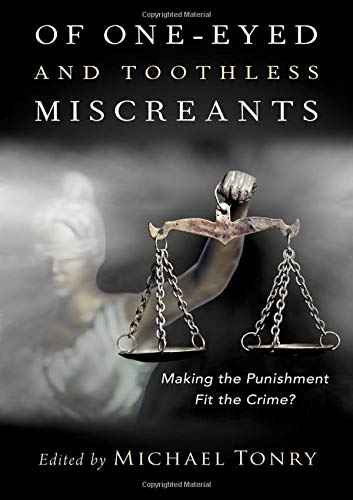Of One-eyed and Toothless Miscreants
Full Title: Of One-eyed and Toothless Miscreants: Making the Punishment Fit the Crime?
Author / Editor: Michael Tonry (Editor)
Publisher: Oxford University Press, 2019
Review © Metapsychology Vol. 24, No. 37
Reviewer: Maura Pilotti
The book entitled Of One-eyed and Toothless Miscreants: Making the Punishment Fit the Crime? is a treat for those who are interested in the administration of justice. Michael Tonry has edited a collection of well-developed commentaries from a variety of scholars. The first thing that the reader may appreciate is the organization of the nine chapters of the book (including the introduction), which brings to the reader a sense of discipline and coherence. Not surprisingly, as the reader progresses through the book, each chapter seems to address the questions that have come to mind while reading an earlier chapter. Narratives may focus on the different viewpoints of a concept, principle, or theme, but one is left with the impression that they all belong to a multi-color fabric that increases in spread, depth, and texture complexity as the last page of a writer’s narrative is turned and a new one, but by a different writer, begins.
Of One-eyed and Toothless Miscreants: Making the Punishment Fit the Crime? is made for a reader who is curious about the unresolved and too-often undefined issues that underlie key concepts of proportionality theory, according to which the severity of punishment has to fit the seriousness of the crime committed. The ideal reader is one who is educated or wants to be educated in matters that peel through the layers of a principle, tenet, or idea, and uncover its essence, potential contradictions, and challenges in its applications to a world that is far from unidimensional. The abstractness of theory and the concreteness of reality are inescapably joint in this book and are one of its most valuable aspects.
The basic tenets of the theory of proportionality make sense. Namely, “no one should be punished more severely than he or she deserves”, and “all else being equal, people who commit more serious crimes should be punished more severely than people who commit less serious ones, and vice versa” (p. 4). Yet, definitions and applications of its main constituents defy the human mind for the complexities and moral challenges that they bring about. Consider, for instance, the concept of the seriousness of a crime. What should be the constituents of the concept contemplated in the administration of justice? Should only injuries caused by intentional actions be considered to define severity? What about negligent, reckless, and, in general, unintentional actions that lead to nefarious outcomes? Namely, to what extent the harmfulness of an action and the culpability of the individual who perpetrated it (as measured by the degree and type of intentionality) should be weighed to determine the seriousness of a crime?
The easy equivalence between crime and punishment that a layperson may expect is another dilemma that the book surgically examines and cleverly dispels. Even if an imperfect, and perhaps controversial definition of seriousness of crime is chosen, the problem of defining the severity of punishment crops up immediately, as the two concepts are intrinsically related, thereby defying simplistic definitions and blind applications. Most importantly, they bring with them key questions that are likely to be asked by sensible people who want to build and maintain a humane society aspiring to values of fairness, equality of opportunities, and justice for all. Among these questions, one may ask whether the severity of the punishment contemplated by sentencing should take into account opportunities for rehabilitation and re-offense probabilities. If so, how is one to determine such probabilities with some degree of certainty? They involve predicting future behavior as well as the social and material contexts in which such behavior is purported to occur.
The book edited by Michael Tonry is a good read in many other different ways. It succeeds in focusing the reader’s attention on a given issue or concept, thereby highlighting the many facets of a matter as well as challenges of conceptualization and application. By doing so, it makes complexity something that the reader can approach, rather than something from which to retreat. The book brings with it historical narratives that offer a needed chronological account of different ideas and issues to further the reader’s understanding of their current realizations. Most importantly, the book gently encourages the reader to think critically about issues that are often simplified in the media to the point of appearing banal. The headlines of newspapers, magazines, and online news aggregators are often evidence that the goal to grab the attention of the readership often comes at the price of depth of analysis. Thus, it is a book that can be used to guide not only lectures and class discussions in undergraduate and graduate college classes, but also the critical thinking of experts and laypersons alike who aspire to a fair and humane society. The only aspect of the book that may benefit from more coverage is attention to scientific evidence regarding the human mind’s response to punishment and related conduct. As we all know, conduct is visible, whereas thoughts and motives are inside one’s mind. Laws are based on principles and logical reasoning developed by human beings who, although erudite and with the best intentions, speculate on the cognitive architecture and information processing tools possessed by those who face the law for alleged crimes. Tools operate within an architecture where emotions guide thinking and shape evaluation. To this end, a review of the research on moral emotive responses (e.g., guilt, shame, empathy) may bring a different, but a much deeper understanding of the issues discussed by the writers of the chapters that comprise the current edited book. To this end, the work of June P. Tangney, a faculty at George Mason University, may be relevant.
Maura Pilotti, Ph.D.
Categories: General
Keywords: Punishment, crime, fairness

